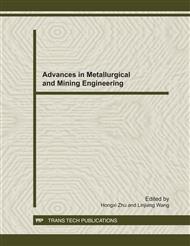p.320
p.326
p.331
p.337
p.345
p.349
p.354
p.358
p.362
Influence of Magnetic Field on as Industrial Waste Water Extraction
Abstract:
With the development of metallurgy and chemical industry, with the exploitation of lean ore recourse, arsenic (As) as an associated by-product has been mined with the exploitation of the main elements. For example, we use pro-oxidation to lixiviate As-Au ore, whose particles are difficult to deal with after its exploitation, fragmentation and rubbing, floatation and nrichment; humid gas acid production is produced by As-Cu ore. These lixivium and waste liquid (industrial waste water) have certain concentration of As. According to the concentration of As, industrial waste water is classified by three kinds; Low As industrial waste water with As100mg/L; Medium As industrial waste water with As 100~300mg/L; High As industrial waste water with As300mg/L; High As can be extracted and enriched through low and Medium As industrial waste water, and then be made into single As through electrolysis sediment or hydration deoxidization. This kind of As waste water can be up to national discharge standard. This experiment is mainly about the influence of magnetic field on As industrial waste water.
Info:
Periodical:
Pages:
345-348
Citation:
Online since:
November 2011
Authors:
Price:
Сopyright:
© 2012 Trans Tech Publications Ltd. All Rights Reserved
Share:
Citation:


